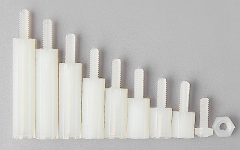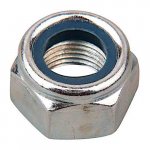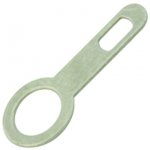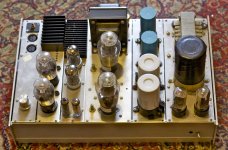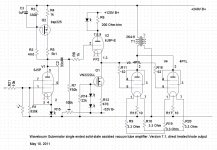I use hex nylon spacers with solder tags on top for all my interiors and that's frankly all that's needed.
Hi Andy,
I read several of your contributions regarding modular assembling of the amplifiers using standard parts (most from 19" rack systems). I like that and I am doing it very similar (I also use open beam) - so I am curious about your implementation of spacers and solder tags (I use NOS Soviet, on ebay look for "point to point wiring") - can you post some pictures?
wish you a nice weekend! Erik
Here's some pictures. I mostly use M3 15mm spacers but carry a stock of shorter and longer. You need the Nyloc nuts to hold the solder tags otherwise the nylon overheats and the nuts come loose. Nyloc nuts hold well. I secure the spacers with a M3 bolt from the top of chassis through the 4mm top plates. So you do end up with visible bolt heads as you can see from the top of the chassis. Underneath it's all point to point.
Attachments
Rod and Ale are the designers and as such sell their own kits - I don't see that changing. Shipping across the pond is one of the realities we have to live with - like us Europeans having to buy 01As from the USA and you Americans having to buy 4P1Ls from Europe. I'm using 2P29L right now so all European. We have Lundahl over here but we import Hammond from Canada and OPTs from Asia. It's a global village.
Bear in mind also that if you use a lot of filament/HT/plate chokes or interstages you don't have much need for a PCB. I use hex nylon spacers with solder tags on top for all my interiors and that's frankly all that's needed.
I usually don't require PCB's in my builds, but with this newest project I will have a CCS load at the anode of the voltage amp stage, a source follower as the driver, and then the filament current regulator along with the fixed bias circuit, I figured I could tidy things up by putting everything on one board instead of going the modular route. It is looking like the modular route is what will end up happening and I will just order the boards from Rod and wait fro them to come across the pond.
Two regulator boards are on their way here courtesy of Rod. Does anyone else get as excited as I do for this sort of thing? I wish I could just sleep until they arrive, I hate waiting!!!!!!!!!!!
I also keep taking out the 4P1L's at night and just stare at them. I am obsessed. These tubes look to me like they are very well constructed. I know I know I should seek professional help but gosh darn these things are sexy
I also can't make up my mind on what I want to use for the voltage amp stage I found two sleeves of 5670's, and I have one WE396a which would probably last a long time. Anybody try these bottles driving a 4P1L? I am curious on how they sound.
I found two sleeves of 5670's, and I have one WE396a which would probably last a long time. Anybody try these bottles driving a 4P1L? I am curious on how they sound.
I also keep taking out the 4P1L's at night and just stare at them. I am obsessed. These tubes look to me like they are very well constructed. I know I know I should seek professional help but gosh darn these things are sexy

I also can't make up my mind on what I want to use for the voltage amp stage
 I found two sleeves of 5670's, and I have one WE396a which would probably last a long time. Anybody try these bottles driving a 4P1L? I am curious on how they sound.
I found two sleeves of 5670's, and I have one WE396a which would probably last a long time. Anybody try these bottles driving a 4P1L? I am curious on how they sound.Sorry, this doesn't really answer your question. I haven't used 5670's but I use 6E5P's which I saw used in a 4P1L amp on the Bartola web page of Ale's, which are quite inexpensive still, as PP drivers in my amp. They sound great compared to the 6n6p's that were in the amp. Must better resolution and the extra gain is very useful in my setup.
John
John
Hi.
Just finished my first 4P1L PSE. Very Must like Andys schematic, but with gyrator and PSE wired in serie. I have only 10 hours on it and I can say for sure It just beat my belowed 2A3. Even if I have my huge Monolith Summit S-9 on it.
I'm using my Sowter S9, 5K as output transformer and it works very nice. I have separate PSU for HV and filament in 2 boxes. I have ordered better Caps for the gyrator and I'll consider to use my V-Cap CuTF 0.1uF, I have as a spare.
But in the meantime I'll just play some music, and give it some time to break in.
A very appreciated thanks to Andy, Ale and Rod and all of you who are an incredible inspiration to me.
Best
Michael
Just finished my first 4P1L PSE. Very Must like Andys schematic, but with gyrator and PSE wired in serie. I have only 10 hours on it and I can say for sure It just beat my belowed 2A3. Even if I have my huge Monolith Summit S-9 on it.
I'm using my Sowter S9, 5K as output transformer and it works very nice. I have separate PSU for HV and filament in 2 boxes. I have ordered better Caps for the gyrator and I'll consider to use my V-Cap CuTF 0.1uF, I have as a spare.
But in the meantime I'll just play some music, and give it some time to break in.
A very appreciated thanks to Andy, Ale and Rod and all of you who are an incredible inspiration to me.
Best
Michael
Well done Michael! As soon as I heard my PSE 4P1L amp all in filament bias I realised that my previous 2a3 and 300b amps were obsolete. While WE know this, almost all of the DIY builders don't know or believe it. They think the 4P1L is just some kind of old Russian thing, whereas in reality it's originally a German military tube. They think the 2a3, 300b and 45 are the pinnacle of directly heated sound. Great tubes of course, but put a cathode bypass cap on them and a directly heated tube like a 12AX7 in front of them because you need the gain, and you've just lost the sound you could have had with a DHT front end. Gone, gone, gone.
Hi Andy.
Couldn't be more agree. I have more gain in my 2A3, so if I need to play loud on material which have very high DR, I just use my 4P1L pre into my new 4P1L PSE.
I know some have been talking about 4P1L into 4P1L is to much, but it works quite well on my setup. I have a Chord 2qute Dac and have eliminated all of my Switch Mode Power Supplies and I'm very satisfied with the result.
The first thing I can said for sure. The 4P1L PSE is dead quiet. First I thought I have made a fault in my build but I just forgot to turn up the volume. I have a pair of homemade enclosure for my ancient Tannoy HPD-385A with internal volume on 303 liter. They are quite efficient but I couldn't hear any noise in a distance off 20 cm. It's total weird.
I had a listening session with a friend just 3 hours after I have checked that everything was working fine. We where listening to a record we have heard 1000+ times before, and there was a lot new stuff going on we never had heard before. Couldn't be more happy.
Couldn't be more agree. I have more gain in my 2A3, so if I need to play loud on material which have very high DR, I just use my 4P1L pre into my new 4P1L PSE.
I know some have been talking about 4P1L into 4P1L is to much, but it works quite well on my setup. I have a Chord 2qute Dac and have eliminated all of my Switch Mode Power Supplies and I'm very satisfied with the result.
The first thing I can said for sure. The 4P1L PSE is dead quiet. First I thought I have made a fault in my build but I just forgot to turn up the volume. I have a pair of homemade enclosure for my ancient Tannoy HPD-385A with internal volume on 303 liter. They are quite efficient but I couldn't hear any noise in a distance off 20 cm. It's total weird.
I had a listening session with a friend just 3 hours after I have checked that everything was working fine. We where listening to a record we have heard 1000+ times before, and there was a lot new stuff going on we never had heard before. Couldn't be more happy.
Filament bias calculation
Guys,
Would like to try the 4P1Lpse with 6e5p as driver, Aly's design. Getting excited and parts are on the way. Will do it CLCLC with 3 chokes, one right after the rectifier tube then split into two supplies. Just want to know how to calculate the current with filament bias.
Albert
Guys,
Would like to try the 4P1Lpse with 6e5p as driver, Aly's design. Getting excited and parts are on the way. Will do it CLCLC with 3 chokes, one right after the rectifier tube then split into two supplies. Just want to know how to calculate the current with filament bias.
Albert
Current for filament bias solely depends on how much filaments draw. 325 mA +/- 25 mA per tube when halves are in series, or 650 mA +/- 50 mA per tube when halves are in parallel.
Current that each anode draws you should estimate by load lines, according to your B+ and output transformer primary impedance.
Then you should calculate the value of caathode bias resistor, summing both current supplied by ande to cathode current and filament current, according to the bias voltage you've selected from load lines.
If you want total current consumed from B+ source, you need to add what the driver consumes. If you want to use Ale's design, you should read carefully what he wrote on his webpage.
Current that each anode draws you should estimate by load lines, according to your B+ and output transformer primary impedance.
Then you should calculate the value of caathode bias resistor, summing both current supplied by ande to cathode current and filament current, according to the bias voltage you've selected from load lines.
If you want total current consumed from B+ source, you need to add what the driver consumes. If you want to use Ale's design, you should read carefully what he wrote on his webpage.
Guys,
Would like to try the 4P1Lpse with 6e5p as driver, Aly's design. Getting excited and parts are on the way. Will do it CLCLC with 3 chokes, one right after the rectifier tube then split into two supplies. Just want to know how to calculate the current with filament bias.
Albert
would love to see your schematic and power transformer choice, as I'm stashing parts currently for the same build.
Cheers,
Gable
In my original design I used 6J5P. They are as good as 6E5P in triode, the same amplification around 30, but still real "sleepers". One more option is Soviet 6J4, in a black metal case. However, today I would use a MOSFET source follower loaded on a CCS, with 1.5-2 times higher negative voltage source, instead of a cathode follower. Why I used a tube then, to avoid capacitances of MOSFETs.
Attachments
That sounds OK. Incidentally, it's Ale not Aly. Short for Alejandro. If you don't need the gain of the 6E5P (around 30) consider the 2P29L (around 9). Depends how sensitive your speakers are and if you have an input voltage of over 2v.
Thanks Andy
I already have some 6e5p in stock and have tried them with 6c33c gyrator load with very good result. Will try 2p29L in the later day.
Albert
So I also built a 4P1L PSE amp courtesy of Andy Evans posting this beautifully simple schematic. Filament bias via Rod Coleman's regulators, Silk Audio output transformer, 290V of B+, 40mA per tube
The thing sounds gorgeous with vocals and instrumental music. I built one channel only so far, and listened to it mono for a few hours. It's driven by Aikido preamp and speakers are Mission M73 connected to 8R tap
Now is it me, or does this set up fall a bit short on rock music with more (heavy) bass? B+ so far is unregulated 50uF - 7H - 50uF supply. I have space in the chassis to add a regulator, SSHV or Maida, will it improve my bass?
I am really on the fence, wrap it up, build 2nd channel and enjoy, or keep tweaking. I know this is DIY and I have to try it all myself, but I would appreciate some nudge in the right direction
Thanks!
The thing sounds gorgeous with vocals and instrumental music. I built one channel only so far, and listened to it mono for a few hours. It's driven by Aikido preamp and speakers are Mission M73 connected to 8R tap
Now is it me, or does this set up fall a bit short on rock music with more (heavy) bass? B+ so far is unregulated 50uF - 7H - 50uF supply. I have space in the chassis to add a regulator, SSHV or Maida, will it improve my bass?
I am really on the fence, wrap it up, build 2nd channel and enjoy, or keep tweaking. I know this is DIY and I have to try it all myself, but I would appreciate some nudge in the right direction
Thanks!
With a 5U4 or other valve rectifier?
The 50µ-7H-50µF storage is too low for hard bass, you are right.
But with thermionic rectifiers, increasing the C values is not a good idea.
Changing to the Wolfspeed SiC rectifiers, and using high quality industrial capactors is one way forward. For my SE, I use 1200V 8A diodes (in a bridge), and 2x 820µF 550V ALS60 (Kemet) per channel. These caps are much better than low-value items, including fancy «audio» types.
The 50µ-7H-50µF storage is too low for hard bass, you are right.
But with thermionic rectifiers, increasing the C values is not a good idea.
Changing to the Wolfspeed SiC rectifiers, and using high quality industrial capactors is one way forward. For my SE, I use 1200V 8A diodes (in a bridge), and 2x 820µF 550V ALS60 (Kemet) per channel. These caps are much better than low-value items, including fancy «audio» types.
- Home
- Amplifiers
- Tubes / Valves
- One more 4P1L SE
